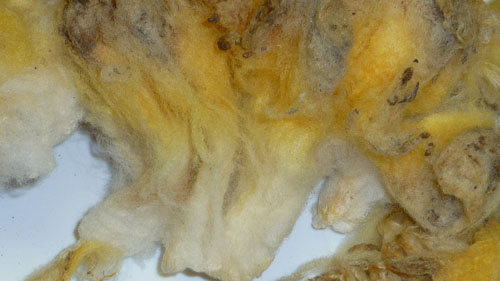Canary staining on raw fleece

Add to the list of hazards of buying fleeces on the cheap (and often from eBay): canary staining. I had never heard of this before today, and now I gotta admit, I am kinda freaked out about it.
Canary staining is caused by a mysterious sheep parasite, and it turns your fleece fluorescent yellow. The color is permanent, and it also can turn gummy with the residue from the parasite. Apparently you can overdye it, but there is no way to remove the canary stain once it has occurred.
Worse still, the canary stain parasite feeds on the lanolin and the wool shaft itself, which causes the fiber to weaken. The parasite will continue to live happily on the fleece after it has shorn, assuming that it isn't killed by extremes of heat, cold, or washing.
This is one of many reasons why many experts (including Judith MacKenzie McCuin) recommend that you always clean a raw fleece before putting it in storage. If the canary stain parasite is in the raw fleece, you can halt its progress (or at least slow it down). Whereas if the fleece is stored raw, the parasite can turn the whole thing gummy and bright yellow.
In addition to damaging the fleece, the canary stain parasite can damage the sheep's immune system and cause deformations on its face. Sheep which are infected by the parasite should be culled and their fleece destroyed, which means that canary stained fleece may indicate a shepherd with poor animal husbandry practices.
When examining your fleece, don't be concerned by "yolk," which is the normal creamy yellow that is caused by lanolin. This buttery yellow shade is actually a good sign in your fleece.
Not sure if you have a fleece that is canary stained or not? Your best bet is to take some good photographs of the staining, and show them to some experts to ask their opinion. (Ravelry's many fleece and spinning forums are an excellent help, here.)
Image courtesy Flickr/jcgilliam

0 comments